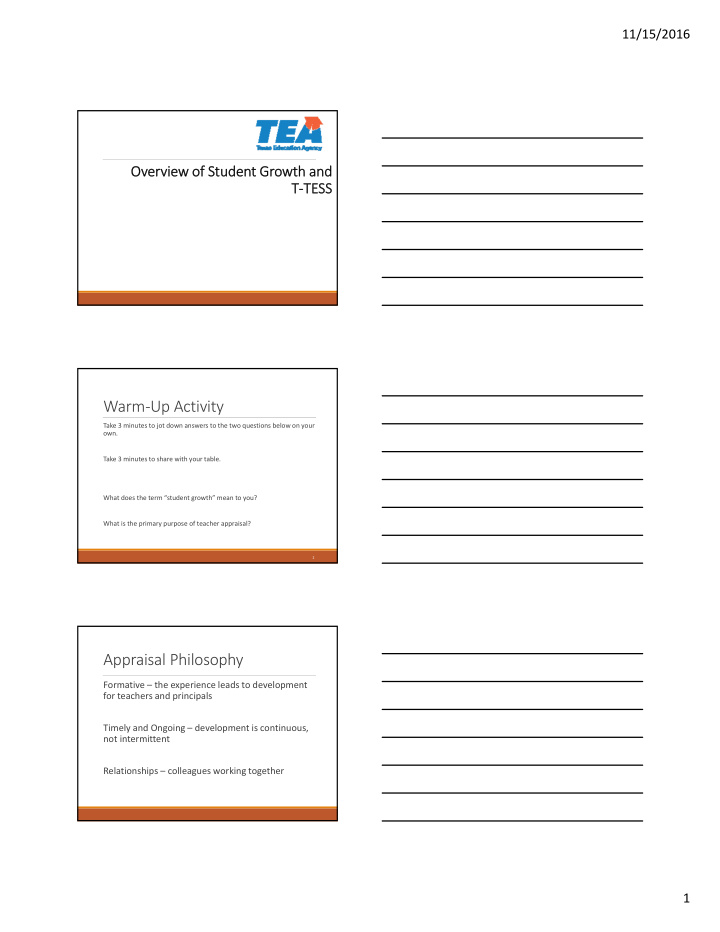



11/15/2016 Ov Over ervie view of of St Studen udent Gr Growth th and and T ‐ TE TESS SS Warm ‐ Up Activity Take 3 minutes to jot down answers to the two questions below on your own. Take 3 minutes to share with your table. What does the term “student growth” mean to you? What is the primary purpose of teacher appraisal? 2 Appraisal Philosophy Formative – the experience leads to development for teachers and principals Timely and Ongoing – development is continuous, not intermittent Relationships – colleagues working together 1
11/15/2016 Philosophy of Individual Growth Maximize Potential – thoughtful, deliberate, evidence ‐ based practices will lead to the best outcomes for each educator. Self ‐ Assessment and Adjustment ‐ building habits of reflection and accurate self ‐ assessment in teachers so that it occurs naturally and regularly. 75,600 instructional minutes during the year. 45 minutes of conferencing in teacher appraisal. Who provides feedback during the other 75,555 minutes? Texas Teacher Evaluation and Support System (T ‐ TESS) Rubric Goal ‐ Setting and Professional Development Process Student Growth ◦ Student Learning Objectives ◦ Value ‐ add scores ◦ Portfolios ◦ District Pre and Post tests Student Growth • Student growth measures will be required as a part of teacher appraisal systems beginning in 2017 ‐ 2018. • Districts may choose from the four possible measures of student growth. • Student growth data, like observation feedback, is for the purposes of making more informed professional development decisions. 2
11/15/2016 Assessment vs. Process Assessment ‐ based student growth: ◦ District pre ‐ and post ‐ tests ◦ Value ‐ added measures ◦ Standardize, objective, comparable Process ‐ based student growth: ◦ Student learning objectives ◦ Portfolios ◦ Granular, timely, context specific feedback SLOs, Appraisal and Student Outcomes SLOs are not a second gradebook. They are: A means to teacher growth (reflect, assess, adjust, and develop over time); A concentrated look at instructional impact through the lens of the most important skill; Results feed into a teacher’s own cycle of development (GSPD plans); and Evidence ‐ based. 8 What SLOs Are Not Determining student growth is not: • Subtracting a beginning ‐ of ‐ year skill number from an end ‐ of ‐ year skill number • Mathematical or mathematically precise • Numerically standardized across a campus or district • Focused on traditional testing 3
11/15/2016 What You Will Hear Us Say… Growth mindset Scoring is the least important part The process is the value Called student growth, but really about teacher growth Honest assessment, sincere reflection, and commitment to adjustment equals student growth 10 The SLO Process A series of questions that, if I answer thoughtfully and thoroughly, should lead to improvements in instruction and student learning. Questions to Start the Course 4
11/15/2016 First Question What are the student skills on which this SLO should focus? Skill and Need Balance between foundational skill(s) I teach in this course, the needs of my students, and needs of the teacher Second Question Where do I think my students will be with these skills upon entering my course? 5
11/15/2016 Third Question Where are my students actually with this skill upon entering my class? Fourth Question Based on where my students actually are with this skill, if I provide effective instruction throughout this course, where should these students be at the end of the course? Questions During the Course 6
11/15/2016 Next Set of Questions What practices and strategies will allow my students (collectively and individually) to progress throughout the course? How are my students progressing in response to these practices and strategies? For those that aren’t progressing appropriately, what changes can I make that may allow me to better reach them? Questions to End the Course First Question How did each student in the SLO progress? 7
11/15/2016 Second Question How did I do in engaging in the SLO process and progressing my students? SLO Outcome Rubrics The rubric combines teacher practices and student outcomes by generally looking at five things: • The quality of the SLO • High expectations in student growth goals • The process of monitoring, analyzing data, and making adjustments to practice • Students making targeted growth • Students exceeding targeted growth Third Question In looking at how my students progressed, what worked, what didn’t work, and, most importantly, what I can improve upon to have a greater effect on all of my students next year? 8
11/15/2016 Reflection Which students met/exceeded targeted growth? Why did this happen? Which student fell below targeted growth? Why did this happen? What will I adjust or improve upon next year based on this data? Areas for improvement could be: • Instructional practices • Instructional strategies • Pacing/scaffolding • Assumptions Alignment with T ‐ TESS Post ‐ conference and end ‐ of ‐ year conference • SLO process as evidence on the T ‐ TESS rubric • Principal practice and the T ‐ PESS rubric • Goal ‐ setting and pd plan • Collaboration • 9
Recommend
More recommend